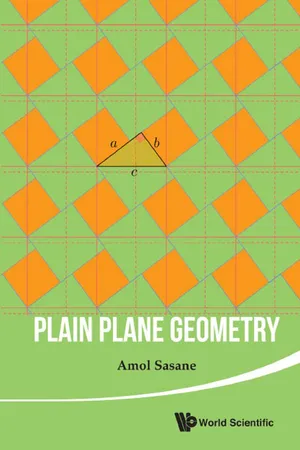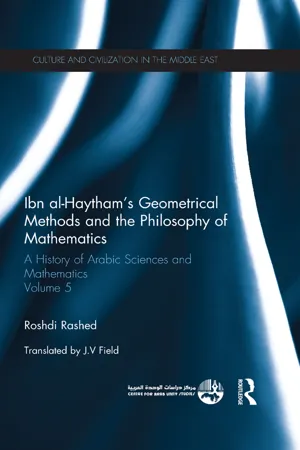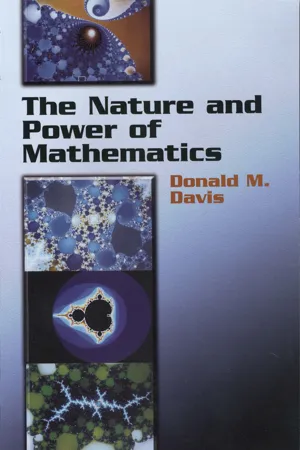Mathematics
Circle Theorems
Circle theorems are a set of rules and principles that apply to circles and their properties. They are used to solve problems involving angles, chords, tangents, and other geometric elements within circles. These theorems are fundamental in geometry and are essential for understanding and solving problems related to circles.
Written by Perlego with AI-assistance
Related key terms
6 Key excerpts on "Circle Theorems"
- eBook - ePub
- Amol Sasane(Author)
- 2015(Publication Date)
- WSPC(Publisher)
Chapter 5Circles
We had defined the terms circle, its center and its radius in Section 1.6 . In this chapter, we will study circles. We begin with some terminology. Recall that a circle C (O, r ) with center O and radius r > 0 is the set of points P in the plane such that OP = r . The set of points P in the plane such that OP < r is called the interior of the circle, while the set of points P for which OP > r is called the exterior of the circle. Circles having the same center are said to be concentric .A line segment joining any two points on the circle is called a chord .A diameter is a special type of chord: it is one which passes through the center of the circle. Clearly the length of any diameter of a circle of radius r is equal to 2r . A diameter divides the circle into two semicircles .Theorem 5.1 . The perpendicular from the center of a circle to a chord bisects the chord .Proof . Let OM be the perpendicular dropped from the center O of the circle C (O, r ) to its chord AB . In the right triangles ΔOAM and ΔOBM , we have OA = OB = r , and the side OM is common. By the RHS Congruency Rule, ΔOAM ≃ ΔOBM , giving AM = MB , as wanted.Theorem 5.2 . The line joining the center of a circle to the midpoint of a chord is perpendicular to the chord .Proof . Let M be the midpoint of the chord AB of the circle C (O, r ). In the two triangles ΔOAM and ΔOBM , we have OA = OB = r , the side OM is common, and AM = BM . By the SSS Congruency Rule, we have ΔOAM ≃ ΔOBM . Hence we obtain ∠OMA = ∠OMB , and being supplementary, they must each equal 90°.Corollary 5.1 . The perpendicular bisectors of two chords of a circle contain its center .We know that two distinct points determine a unique line passing through them. We can now ask: - eBook - ePub
- Edward T Walsh(Author)
- 2014(Publication Date)
- Dover Publications(Publisher)
Problem Set 8.4 . It is one of the theorems attributed to that earliest deductive mathematician, Thales.COROLLARY T91(a) An angle inscribed in a semicircle is a right angle.COROLLARY T91(b) Angles inscribed in the same arc or in congruent arcs are congruent.Example 1 Given the figure, m = 100, and m = 130. Therefore, m = 360 − (100 + 130) = 130. By T91 we have:m∠A = m = 65m∠B = m = 50m∠C = m = 65The next definition is needed for the following theorem.DEFINITION 8.12 Let be tangent to any circle at A. Then is called a tangent ray to that circle at A. Let be a secant of a circle, ) a chord.Then (and ) is a secant ray of that circle.THEOREM 92 If a secant ray and tangent ray have a common end-point, then the measure of the angle formed is one half the measure of the intercepted arc.Proof: There are two cases to consider.Case 1: The center of the circle is in the exterior of the angle, as in the figure. Adding the auxilary segments shown, we can write (letting lowercase letters represent measures of angles or arcs) :y + z = 90which implies that2y + 2z =180From the Angle Sum Theorem we conclude that2y + x =180Therefore, x = 2z, or z = x.Case 2: The center of the circle is not in the exterior of the angle. The proof for this case is left as an exercise.THEOREM 93 In the same circle or congruent circles, if two chords that are not diameters are congruent, then the corresponding minor arcs are congruent.Given: Circle P ≅ circle Q, andProve: Minor arc ≅ minor arcProof: By the SSS theorem ΔAPB ≅ ΔCQD. Therefore, ∠P ≅ ∠Q. Since m = m∠P and m = m∠Q, it follows that m = m , or .THEOREM 94 In the same circle or congruent circles, if two arcs are congruent, then the corresponding chords are congruent.Proof: There are three cases to consider.Case 1: The congruent arcs are minor arcs. The circles shown suggest a simple proof using congruent triangles.Case 2: - eBook - ePub
Ibn al-Haytham's Geometrical Methods and the Philosophy of Mathematics
A History of Arabic Sciences and Mathematics Volume 5
- Roshdi Rashed(Author)
- 2017(Publication Date)
- Routledge(Publisher)
CHAPTER I THE PROPERTIES OF THE CIRCLE INTRODUCTION The long list of mathematical works written by Ibn al-Haytham includes several that are still missing. Among these are three that, in the mathematics of infinitesimals, speak for themselves: The Greatest Line that can be Drawn in a Segment of a Circle, a Treatise on Centres of Gravity and a Treatise on the Qarasṭūn. These treatises are all concerned with the geometry of measure. Their absence not only deprives historians of mathematics of facts that would have helped them to appreciate more clearly the range of Ibn al-Haytham’s oeuvre, but also, more seriously, it makes it absolutely impossible for them to understand the structures of this oeuvre and the network of meanings that they carry. If the first of the treatises cited above had been at our disposal, we should have a better understanding of the distance the author of a treatise on problems of figures with equal perimeters, on figures with equal areas and on the solid angle, travelled along the road of what was later to be called the calculus of variations. This state of affairs is not peculiar to the geometry of measure; it is found also in the other type of geometry developed by Ibn al-Haytham and his predecessors: the geometry of position and forms. Among the books that until very recently were still missing we have one with the title On the Properties of Circles. A book with such a title is of course intriguing and surprising. 1 We ask ourselves what Ibn al-Haytham might deal with in a book whose title appears so strikingly modern. His predecessors, his contemporaries and Ibn al-Haytham himself wrote books and papers on one or another aspect of a geometrical figure, for example triangles, but rarely on all its properties taken together as a whole. Furthermore, Ibn al-Haytham had written more than once on the circle, on finding its perimeter and finding its area - eBook - ePub
- Hugo Hadwiger, Hans Debrunner, Victor Klee(Authors)
- 2014(Publication Date)
- Dover Publications(Publisher)
Part I1. Incidence of Points, Lines, and Circles The propositions of this first small group deal with incidence relations among points, lines, and circles, and thus pertain to combinatorial elementary geometry.1. If a finite set of points is such that on the line determined by any two of the points there is always a third point of the set, then all the points lie on a single line.This theorem was conjectured in 1893 by J. J. Sylvester [102] . A short proof due to T. Gallai (Grünwald) is given by N. G. de Bruijn–P. Erdös [9] , where the result appears as a corollary of a purely combinatorial theorem. For further proofs, generalizations, and variants see P. Erdös [16] , H. S. M. Coxeter [10] , G. A. Dirac [13] , and Th. Motzkin [76] .2. If a finite set of lines is such that through the intersection point of any two of the lines there always passes a third line of the set, then all the lines pass through a single point.Propositions 1and2are no longer true if the sets of points or lines are infinite. This is demonstrated for both theorems simultaneously by the example of the regular countably infinite system of points and lines pictured in Figure 1 .3. If a finite set of points, not all collinear, is such that on the circle determined by any three of the points there is always a fourth point of the set, then all the points lie on a single circle.A set is said to be bounded if it lies in some circular disk of finite radius, closed if it includes all its limit points, where a point p is a limit point of a set X if every disk centered at p includes a point of X different from p. In both hypothesis and conclusion, the following theorem is closely related toProposition 3.4. If a bounded closed set of points is such that the axis of symmetry for any two of its points is always an axis of symmetry for the entire set, then all the points lie on a single circle.It is easy to see thatPropositions 3and4are invalid for sets that are both infinite and unbounded. Indeed, it suffices to consider the entire plane as the set of points in question. An example consisting of countably many points may be constructed as follows : Let A0 be a set of four points not lying on any line or circle. Then let an increasing sequence of finite sets An (n - eBook - ePub
- Roger A. Johnson(Author)
- 2013(Publication Date)
- Dover Publications(Publisher)
The circles orthogonal to the given circle, the one at A and C and the other at B and D, will intersect at two points X and Y. Let X be a center of inversion, then the circles ACX and BCX invert into lines intersecting at Y ′, and the given circle into a circle orthogonal to them, with its center therefore at Y ′. Hence A′C′ and B′D′ are diameters, and the figure is a rectangle. 133. Some of the foregoing theorems, and others of the sort, are intimately related to the following general theorem. Theorem. If two polygons are inscribed in the same circle, and the connectors of corresponding vertices are concurrent at a point C, the inverse of either polygon with regard to C as center of inversion is homothetic to the second polygon. For as we saw in the proof of 71, the mutually inverse points are antihomologous on the given circle and its inverse. Hence the points here in question are homologous, with C as homothetic center. Numerous applications of this theorem are obvious. The form of the triangle inverse to a given triangle is at once determined when the center of inversion is specified. In the proof of the second theorem of 132, if either X or Y be connected with the four given points, the connectors meet the circle again at the vertices of a rectangle. As another application, we may consider the harmonic quadrangle. Definition. Any quadrangle whose vertices are inverse to those of a square is a harmonic quadrangle. Theorem. A cyclic quadrangle is harmonic if and only if the products of its opposite sides are equal. For this is a property of a square, and of no other rectangle; and by 68 c the property is unchanged by an inversion. Theorem. Lines from the vertices of a square through any point cut the circumscribed circle in the vertices of a harmonic quadrangle. POLES AND POLARS 134. The theory of poles and polars belongs properly to the domain of projective geometry, and can hardly be adequately treated by elementary methods - eBook - ePub
- Donald M. Davis(Author)
- 2013(Publication Date)
- Dover Publications(Publisher)
Here it would be applied to the arc of the second circle that connects a point inside the first circle with one outside it. This may seem pedantic, but to become comfortable with non-Euclidean geometry, you must divorce yourself from your intuition and just think logically. In modern mathematics, there are forms of geometry in which circles do have tiny holes and might not intersect. 11 In Section 2.1, we will point out how Hilbert’s modern form of “plane geometry made rigorous” handles questions such as this. Even with the added postulate above, there is another worry: How do we know that the second circle contains points both inside and outside the first circle? Worrying about this may be stretching your credulity; however, in one of the forms of non-Euclidean geometry (spherical) we will study, sometimes the second circle stays totally inside the first, so that there is no point of intersection, and hence no equilateral triangle. For most of the purposes of this book, Euclid’s level of rigor is perfectly appropriate, and we need not dwell on fine points, as we have done above. As noted earlier, all of Euclid’s results are correct in the sense that they can be rigorously deduced from a set of postulates which extends his slightly. Many geometry texts (such as Prenowitz and Jordan 1965) illustrate how overreliance on diagrams can actually lead to incorrect conclusions in geometry. The “Aside” at the end of this section tells a story of how such overreliance led to a highly publicized incorrect proof of a famous conjecture in 1986. Postulate 3 is the principal ingredient in the proofs of the next two propositions, whose proofs we omit. Exercise 3 asks you to prove Proposition 3; think how you would do it if you had a compass, and try to formalize it. PROPOSITION 2
Learn about this page
Index pages curate the most relevant extracts from our library of academic textbooks. They’ve been created using an in-house natural language model (NLM), each adding context and meaning to key research topics.





